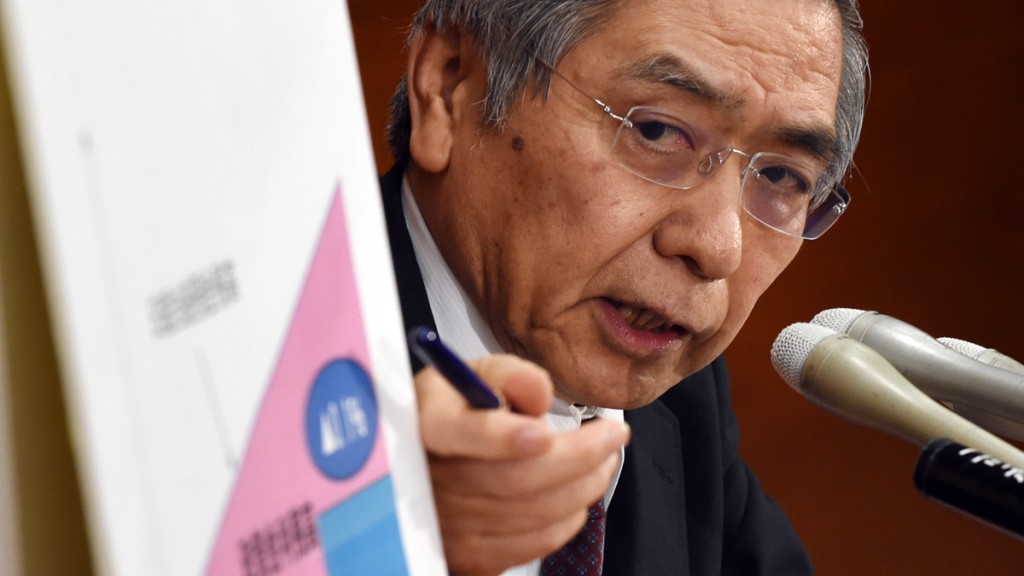
One of the biggest misconceptions floating around the market right now is the idea that central banks have run out of tricks.
Let me make something clear: I don’t think that central banks can control markets (although they can entirely screw the market mechanism up, which is a different thing). I don’t think they’re helping matters. And I think that quantitative easing has done a lot more harm than good.
But the idea that central banks have reached the limits of what they can do is blessedly naïve. Wishful thinking, even.
Central banks never run out of ammunition. They can print as much as they want. They can make rates as negative as they like. The only question is: at what point does the collateral damage become so great that they decide to stop?
And we’re nowhere near there yet…
Kuroda gets serious
This morning, the Bank of Japan (BoJ) demonstrated once again that the most powerful weapon in the central banker’s armoury is the art of surprise.
Japanese stocks jumped by near-enough 3% this morning as central bank boss Haruhiko Kuroda turned Japanese rates negative.
As the FT put it: “The Bank of Japan has slashed interest rates to minus 0.1% in a shock move that adds a new dimension to its record monetary stimulus.”
The move was entirely unexpected. It came this morning, as the Bank was forced to downgrade its expectations for inflation this year. And the two are clearly connected.
This was – as our Asia expert Rupert Foster pointed out to me this morning – a bit of a reminder to the market that the BoJ “hasn’t gone soft on QE and its drive to raise the CPI to 2%”. Given the downward revision in the CPI forecast for this year (from 1.4% to 0.8%), it “had to announce something to show commitment”.
When you look at the small print, the reality is that this negative rate policy is less radical than it might sound at first.
The idea behind negative rates is as follows: the central bank starts charging other banks to hold the money that they have sitting in their reserves. The idea is that they then become keen to find better uses for said money.
However, the negative rate will apply to a much smaller proportion of these reserves than we’ve seen in European countries with negative rates, notes the FT.
So “this makes the negative rate much weaker than comparable moves by the European Central Bank”.
Even so, it’s a pretty big visual cue – that great big “minus” sign in front of your base rate – and it took the market by surprise. Just over a week ago, Kuroda told the Japanese parliament that he was “not seriously considering” a negative rate.
So much for that. The yen – which has been strengthening somewhat this year – immediately took a dive against the dollar, as this latest shot in the currency wars was fired.
So what’s worrying the Bank? There’s nothing wrong with the Japanese economy, it assures us. Instead, falling oil prices and a weaker China are the problem. The fear is that this will prevent the rapid “conversion of the deflationary mindset” in Japan.
In short, this is another central bank “whatever it takes” moment. It’s a reminder to markets: “You think we’re out of ammo? Trust me. You ain’t seen nothing yet.”
You should be buying Japan anyway
Central banks hell bent on keeping share prices up and currency levels down have so far been able to get what they want. That’s why we’ve suggested that investing where central banks are most active is not a bad idea.
But Japan is worth buying anyway. John Authers had a good column in the FT yesterday on why Japan’s fundamentals look good.
A quick run through of the bull points raised: Japan’s cyclically-adjusted price/earnings ratio, while high compared to that of other countries, is now at 25, “far below its median since 1969”.
Those sectors hit hardest by the resources slump “have only been cheaper than this 5% or less of the time since then”.
Meanwhile, Japanese companies have loads of cash, and the government is putting them under pressure to hand it back to shareholders in the form of dividends or buybacks. And profitability is improving – it’s double what it was 20 years ago.
This only really adds to that. So stick with Japan. It’s always been one of our favourite markets and we’re not for bailing out now.
Oh and by the way, if you want an idea of just how much loopier central bank policy could get, you should read my colleague Tim Price’s “War on Cash” book if you haven’t already. You can get it here.